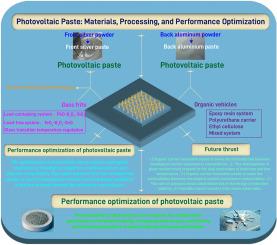光伏浆料综合综述:材料、加工、性能优化
IF 6.3
2区 材料科学
Q2 ENERGY & FUELS
引用次数: 0
摘要
针对光伏产业对高效、低成本、可持续的金属化浆料的迫切需求,针对目前缺乏系统整合的多组分协同机制和可持续发展路径进行了综述。本文综合分析了导电材料、玻璃粉、有机载体和浆料中添加剂之间的跨尺度相互作用。通过量化含铅玻璃体系(如PbO-B2O3-SiO2,电导率为2.62 μΩ cm)和无铅替代品(如TeO2-Bi2O3-ZnO,电导率仅为0.029 Ω cm2)之间的潜在性能差距,本文提出了通过低温烧结和界面改性的补偿策略。构建了贵金属还原技术的系统图谱,展示了Cu-Ag核壳结构(9% Ag负载)和梯度印刷(减少40%银和提高0.5%效率)的协同优化潜力。此外,设计了一个创新的全链可持续解决方案,包括智能载体(温度响应聚合物),界面强化(银纳米岛+分子弹簧层)和闭环回收(选择性银溶解>; 90%使用离子液体)。本研究为突破光伏浆料“性能-成本-环保”不可能三角提供了首个跨尺度设计框架。本文章由计算机程序翻译,如有差异,请以英文原文为准。

Comprehensive review of photovoltaic paste: Materials, processing, and performance optimization
Addressing the photovoltaic industry's urgent need for efficient, low-cost, and sustainable metallization pastes, this review targets the existing lack of systematic integration of multi-component synergistic mechanisms and sustainable development pathways. This review comprehensively analyzes the cross-scale interactions between conductive materials, glass powder, organic carriers, and additives in pastes. By quantifying the underlying performance gap between lead-containing glass systems (e.g., PbO-B2O3-SiO2, with a conductivity of 2.62 μΩ cm) and lead-free alternatives (e.g., TeO2-Bi2O3-ZnO, with a conductivity of only 0.029 Ω cm2), this review proposes compensatory strategies through low-temperature sintering and interface modification. A systematic map of precious metal reduction technologies is constructed, demonstrating the synergistic optimization potential of Cu-Ag core-shell structures (9 % Ag loading) and gradient printing (reducing silver by 40 % and increasing efficiency by 0.5 %). Furthermore, an innovative, full-chain sustainable solution is designed, encompassing intelligent carriers (temperature-responsive polymers), interface strengthening (silver nano-islands + molecular spring layers), and closed-loop recycling (selective silver dissolution >90 % using ionic liquids). This research provides the first cross-scale design framework for breaking through the impossible triangle of “performance-cost-environmental protection” of photovoltaic pastes.
求助全文
通过发布文献求助,成功后即可免费获取论文全文。
去求助
来源期刊

Solar Energy Materials and Solar Cells
工程技术-材料科学:综合
CiteScore
12.60
自引率
11.60%
发文量
513
审稿时长
47 days
期刊介绍:
Solar Energy Materials & Solar Cells is intended as a vehicle for the dissemination of research results on materials science and technology related to photovoltaic, photothermal and photoelectrochemical solar energy conversion. Materials science is taken in the broadest possible sense and encompasses physics, chemistry, optics, materials fabrication and analysis for all types of materials.
 求助内容:
求助内容: 应助结果提醒方式:
应助结果提醒方式:


